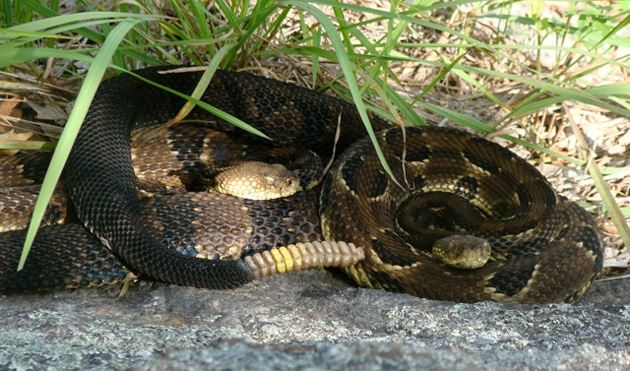Rattlesnakes Not So Cold Hearted
SDSU biologist Rulon Clark finds the slithery creatures tend to stick with family.

Snakes have long been characterized as anti-social creatures, but new research from San Diego State University finds certain species are more socially advanced than previously thought.
SDSU biologist Rulon Clark and his fellow researcher used molecular tools to characterize the genetic relation of groups of timber rattlesnakes captured in the field. Results showed that both juveniles and pregnant females tend to group with relatives.
“This kin-based social structure indicates that cryptic, secretive animals like snakes may have richer, more complex social lives than currently appreciated,” Clark said.
“It can be difficult for us to observe these animals in the wild directly, both because of their secretive nature and because they seem alien to us. They don't have facial musculature that gives them familiar expressions, or hair or feathers that make them cute or fuzzy, so their behaviors aren't as familiar to us as other animals might be.”
A snake's social life
Researchers collected samples from 29 pregnant females at birthing sites and 419 rattlesnakes at basking sites throughout New York and Pennsylvania.
“Some of the pregnant female relatives found together were either full siblings or mother-daughter pairs, and others were probably more distant relatives,” Clark said.
For the juvenile relatives found together, they were all either full siblings or half siblings, most likely from the same litter.
Why so family friendly?
Why the slithery creatures lived in family groups is still in question.
“At this point, our best guess is that these individuals may benefit from cooperative thermoregulation, cooperative defense or maybe both,” Clark said.
Thermoregulation refers to the ability of cold blooded animals like reptiles to maintain optimal body temperatures. Thermal inertia allows larger masses to maintain higher temperatures than smaller ones, so groups of snakes huddled together may be able to maintain more optimal temperatures than individual snakes could on their own.
Future research
Clark said future research will look into whether this social structure is present in other rattlesnake species or even pit vipers.
“The social lives of most species remain largely unexamined and I expect we'll be able to say a lot more about the social lives of these species in the near future.”
The study was published online this week in the journal Biology Letters.



